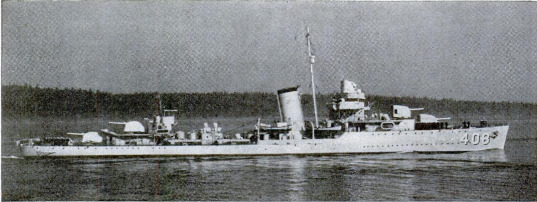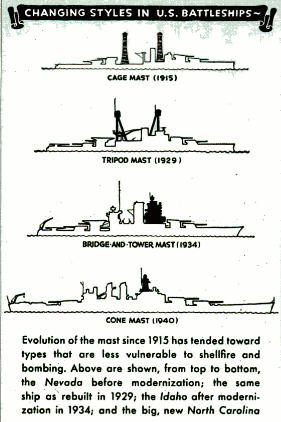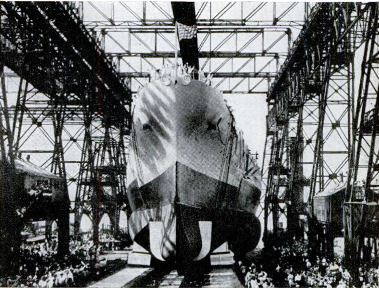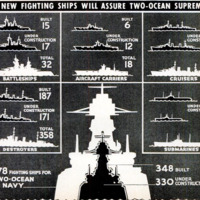-
Title (Dublin Core)
-
America starts work on world's biggest navy
-
Article Title and/or Image Caption (Dublin Core)
-
Title: America starts work on world's biggest navy
-
extracted text (Extract Text)
-
WITHIN four years the war fleet of
the United States will be the might-
jest armada the world has ever
seen. Three hundred and thirty new ships,
added to the present 348, will give us our
long-awaited two-ocean navy, a fighting
force capable of defending both coasts si-
multaneously.
The new warships—17 battleships, 48
cruisers, 12 aircraft carriers, 171 destroyers,
and 82 submarines—will represent the last
word in the evolution of fighting craft, and
innovations among them may foreshadow
the whole future of naval warfare.
Of the seventeen battleships, the first six
will be of 35,000 tons and carry nine sixteen-
inch guns apiece in their main batteries.
They will be the biggest, most powerful, and
speediest battleships we have ever built.
Two of them, the North Carolina and Wash-
ington, have been launched and are due for
completion in 1941. Keels have been laid
for the rest—the South Dakota, Indiana,
Massachusetts, and Alabama.
In appearance, their most striking fea-
ture will be their conical masts, rising like
lighthouses to present a new silhouette
against the sky. Cage masts, once typical
of U. S. battleships, proved too unsteady
for mounting precision fire-control instru-
ments. Tripod masts, which superseded
them, were steadier and could have one or
even two legs shot away—but fell with the
loss of the third. More recently has ap-
peared the bridge-and-tower structure,
typified in our modernized Idaho and Eng-
land's Nelson, whose tars have named it |
“Queen Anne's mansions” for its resem-
blance to a group of London flats. With
the modern trend away from elaborate su-
perstructure that an air bomb could turn
into splinters of flying steel, styles for bat-
tleships have changed again, and the cone
mast is the result. It houses fire-control
apparatus that trains the big guns; a stub-
bier mast aft allows unobstructed antiair-
craft fire.
Even greater battleships are soon to come.
The superdreadnought owa now building
at the New York Navy Yard will be fol-
lowed by the New Jersey, Missouri, Wis- |
consin, and seven more, all of 45,000 tons |
or larger. They will outclass at least four
and probably eight battleships of 40,000 tons
or more that Japan now is believed to be
building.
First descriptions of the Iowa, New Jer |
sey, and their sister ships indicate 45,000-
ton size and an armament of nine sixteen-
inch guns, the same as for the smaller North
Carolina class. The difference in tonnage
would be used to increase the speed of the |
larger ships. But plans for later battle |
ships of the program, at least, may be re-
vised. Recent Navy studies favor increas- |
ing the monster size of these floating for-
tresses to 50,000 or 52,000 tons, with perhaps
twelve big guns. Also, it recently has been
revealed that the Navy is experimenting
with an eighteen-inch gun, the most power-
ful in the world. Proving-ground tests will
determine whether it may be adopted for
use on our biggest ships.
Twelve aircraft carriers in our two-ocean
naval program will benefit from our expe-
rience with a wide variety of types. “The
bigger, ‘he better” doesn't seem to hold true
for vessels of this category. Carriers are
admittedly the most vulnerable of warships,
and naval circles believe that the big, 33,000-
ton Lexington and Saratoga carry “too
many eggs in one basket” for comfort. Con-
versely, the 14,700-ton Wasp, which used
up the tonnage allowed us for carriers in a
treaty now expired, is regarded as smaller
than the ideal size.
So the Hornet, Essex, Bon Homme Rich-
ard, Intrepid, Kearsarge, and seven more of
our new carriers are expected to be pat-
terned more nearly after the 20,000-ton
Yorktown and Enterprise, completed in
1938. These highly satisfactory craft can
carry 100 planes apiece, and are credited
with the high speed of more than thirty-two
knots. To save time in bringing air-
craft up to the flight deck in an eleva-
tor, some can be launched by catapult
from the hangar deck below. Despite
the claims of speed upon tonnage,
enough weight is left over to provide
light armor, and also torpedo protec-
tion—an advantage emphasized by the
torpedoing and sinking of the British
carrier Courageous.
New cruisers will include many sizes
and types. One of the most interest-
ing is a new 6,000-ton design, smallest
built for the U. S. Navy in many
years. Exceptionally speedy and eco-
nomical, these ships should prove ideal
for convoying and patrolling shipping
lanes. Four of them, the Atlanta,
Juneau, San Juan, and San Diego,
were laid down in 1040. At the other
end of the size range, we may expect
enlarged editions of the 10,000-tonners
we have been building, whose latest
examples are the eight-inch-gun
Wichita and the six-inch-gun Helena.
A total of 171 destroyers ln the cur-
rent building program will replace,
many times over, the fifty old ones
that were traded to Britain for in-
valuable naval bases. Among the lat-
est in service, the largest can fire the
world’s heaviest torpedo salvo to either
beam from their twelve deck-mounted
tubes. U. S. destroyers now better
forty knots, zigzag with incredible re-
sponsiveness to a touch on their electro-
hydraulic steering controls, and come to a
“crash stop” from full speed ahead in less
than three times their own length. Similar
or better performance may be expected of
the ones under construction, which are like-
1y to follow a world-wide trend toward larg-
er dimensions—constantly narrowing the
distinction between destroyers and small
cruisers. .
Most of eighty-two submarines now con-
tracted for, will be of the “fleet type” of
about 1,500 tons, capable of extended ocean
cruises either with the battle force or as lone
commerce raiders. Orders also include, how-
ever, a new type of only 800 tons which
would be used for coastal patrol.
OVER and above these 330 fighting ships
of the principal naval categories, we are
building a host of minor warships and auxil-
iaries, scarcely less essential. Under con-
struction at the Philadelphia Navy Yard,
the 6,000-ton U. 8. 8. Terror will be our first
mine layer specifically designed for the pur-
pose. In the last war, merchant ships were
acquired and converted into mine layers.
Other items on the Navy's shopping list in-
clude “mother ships” for destroyers and sub-
marines, armed landing boats to ferry men
and thirty-mile-an-hour tanks ashore on a
beach, a mosquito fleet of sub chasers and
motor torpedo boats, and ships to lay and
tend antisubmarine nets at naval and com-
mercial harbors.
WHEN will the Two-Ocean Navy be
completed? Normally it takes four
years or more to build a battleship, three
years for an aircraft carrier or cruiser, and
two years for a destroyer or submarine. Al-
50, all the country’s shipyards lack capacity
to handle at once the vast order they have
received. But erecting mew shipbuilding
ways, and adding extra shifts of workers,
toiling at night under the glare of flood-
lights, is speeding up the program almost to
wartime pace. Orig-
inally it was expected
to be finished by 1946,
but Admiral Harold
R. Stark, Chief of
Naval Operations,
now predicts that at
least the bulk of the
ships will be ready by
1944.
To take care of
whatever may happen
in the meantime, the
Navy is making the
most of every avail-
able craft, new and
old. Pending comple-
tion of the new naval
air base at San Juan,
in Puerto Rico, the
ancient and demilitar-
ized battleship Wyom-
ing has been restored
to duty as a tender
for long-range patrol
planes. Many private
yachts, sold or presented to the Navy by
their owners, are being refitted as patrol
vessels. Thirty-six old submarines are being
put back into service. Recommissioned de-
stroyers have been converted into “aircraft
destroyers” and speedy troop transports.
Thus, ready to meet any emergency, the
fleet stands guard—constantly reénforced
as the new fighting ships come sliding down
the ways. We shall not have to wait until
1944, or any other year, to see a fleet of
warships handed over to the Navy at one
grand stroke. More and more often, we shall
see those little headlines about a new sub-
marine launched, or a destroyer commis-
sioned. Each one serves as a reminder that
our Two-Ocean Navy is already materializ-
ing before our eyes.
-
Contributor (Dublin Core)
-
Alden P. Armagnac (article writer)
-
Language (Dublin Core)
-
Eng
-
Date Issued (Dublin Core)
-
1941-01
-
pages (Bibliographic Ontology)
-
122-125
-
Rights (Dublin Core)
-
Public domain
-
Archived by (Dublin Core)
-
Sami Akbiyik
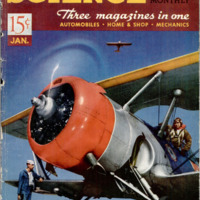 Popular Science Monthly, v. 138, n. 1, 1941
Popular Science Monthly, v. 138, n. 1, 1941

